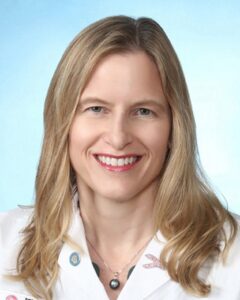Dear Breast Imaging Radiologist,
After my last routine mammogram, I was told, “You have dense breast tissue.” I stared at the report, a silent “What does that even mean?” hanging in the air. Until then, the concept of breast density had been completely off my radar. Then, I was left wondering: Was this a ticking time bomb? Did this predispose me to breast cancer in a way I had not considered? What, if anything, should my next steps be regarding screening frequency or type? It felt like an important piece of health information that too many of us were only discovering by accident, leaving us to navigate a confusing landscape of uncertainty.
Sincerely,
Worried Woman
Dear Worried Woman,
Learning results of medical imaging tests can sometimes be confusing or unsettling, especially for breast health. But new federal legislation aims for women to be informed about breast density, so that they can make the best personal decisions about screening and follow-up.
Let’s clarify what “dense breast tissue” means.
First, is it a “ticking time bomb”? No, it is not an indicator of cancer itself. Having dense breast tissue does not mean that you have cancer or that you will get cancer. However, it is an independent risk factor for breast cancer. Women with dense breasts have a slightly higher risk of developing breast cancer. Also, having dense breast tissue can make the interpretation of your mammogram more challenging. A small cancerous growth might show up on a mammogram as a white mass. Dense breast tissue also appears white on a mammogram, which can make an abnormality harder to see.
Breast density refers to breast composition and its appearance on a mammogram. You can’t tell if you have dense breast tissue by physical exam alone. Normal breast tissue contains fibrous, glandular and fatty tissue. “Dense breasts” means a higher proportion of fibrous and glandular tissue over fatty tissue.
Radiologists classify breast density into four categories, which will be reported in your mammogram:
- Almost entirely fatty
- Scattered fibroglandular density
- Heterogeneously dense
- Extremely dense
If your tissue is categorized as heterogeneously or extremely dense, that means you have “dense breasts.” Approximately half of all women who undergo mammography have dense breasts. Advocacy groups have fought hard for the new federal regulation so that women may be given this information, leading to the best personal choices regarding breast cancer screening.
For some women with dense breasts, supplemental screening such as breast ultrasound or breast MRI may be recommended. At the Fortunato Breast Health Center at Mather Hospital, we have been recommending the addition of breast ultrasound to annual mammography for women with dense breast tissue for more than 20 years.
Additionally, it is always important to know how your breasts normally look and feel. Consider performing breast self-exams. Report any changes like a new lump or nipple discharge to a healthcare provider right away, regardless of your last mammogram.
Understanding your breast density empowers you and your healthcare team to tailor the most effective breast cancer screening plan, for early detection and peace of mind.
Sincerely,
Michelle Price, MD Breast Imaging Radiologist
Patients should remember that they have a choice for their care, and choosing the Fortunato Breast Health Center means opting for a level of support, expertise and cutting-edge technology designed to provide confidence and peace of mind. Do not delay. Schedule your mammogram today (631) 476-2771.
Resources
https://www.bcrf.org/about-breast-cancer/dense-breast-tissue/


